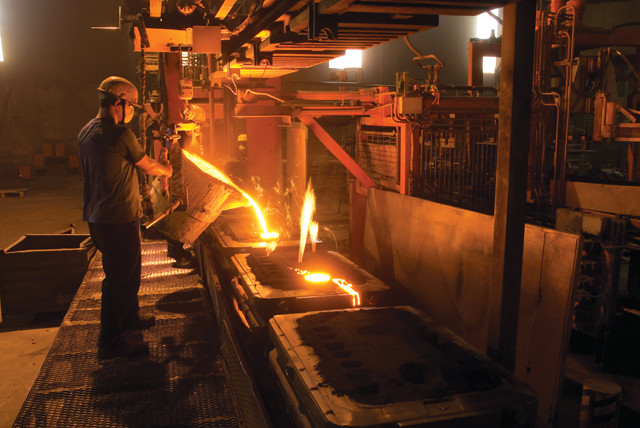
by U.S. Geological Survey Thursday, June 14, 2018
Hendrik G. van Oss, a mineral commodity specialist for the U.S. Geological Survey, compiled the following information on ferrous slag, which is primarily used in construction.

Ferrous slag is a byproduct of iron- and steelmaking. Credit: © iStockphoto.com/muzaffer topuz
Ferrous slag is a byproduct of iron- and steelmaking. It is produced through the addition of materials such as limestone, dolomite, lime and silica sand to blast furnaces and steel furnaces to strip impurities from iron ore, scrap and other ferrous feeds, and to lower the heat requirements of the iron- and steelmaking processes. The slag forms as a dominantly calcium silicate melt that floats on top of the molten crude iron or steel; the slag is then removed from the liquid metal.
Because most forms of processed slag are only worth a few dollars per ton, steel companies generally contract with outside groups to remove, cool, process and sell the slag. The method of cooling is key to the market uses for the slag — and to its value.
Air-cooled blast furnace slag and steel slag are cooled under ambient conditions; the slags are hard, dense and especially suitable for use as aggregates in building materials. Granulated blast furnace slag is formed by quenching molten slag in water to form sand-sized particles of glass. When finely ground, granulated slag is a hydraulically cementitious material that is useful as a partial substitute for portland cement in concrete and, for this reason, commands prices typically in excess of $50 per ton. Other types of slag can be used as a lightweight aggregate in construction, in glass manufacturing or as “mineral wool,” used in thermal insulation.
Using ferrous slag as a raw material for manufacturing clinker — the nodules formed in the manufacturing of portland cement — reduces the “carbon footprint” of cement manufacture. Using granulated blast furnace slag to replace some of the portland cement in concrete reduces the carbon footprint of concrete and generally improves the quality of the concrete. For most aggregate uses, ferrous slag competes in the market with crushed stone and sand and gravel.
Although a steel company will know precisely the amount of slag in a furnace at any given time, the total quantity of slag produced is not routinely measured. World output of blast furnace slag was estimated to be 240 million to 280 million metric tons in 2007; world output of steel slag was estimated to be 130 million to 200 million metric tons. Ferrous slag output varies in proportion to crude iron and steel production. For typical iron ore grades (60 to 66 percent iron), blast furnace slag output will be about 0.25 to 0.30 tons per ton of crude iron produced. Steel furnace slag production, after removal of entrained metal, will be about 10 to 15 percent of the crude steel output.
© 2008-2021. All rights reserved. Any copying, redistribution or retransmission of any of the contents of this service without the expressed written permission of the American Geosciences Institute is expressly prohibited. Click here for all copyright requests.